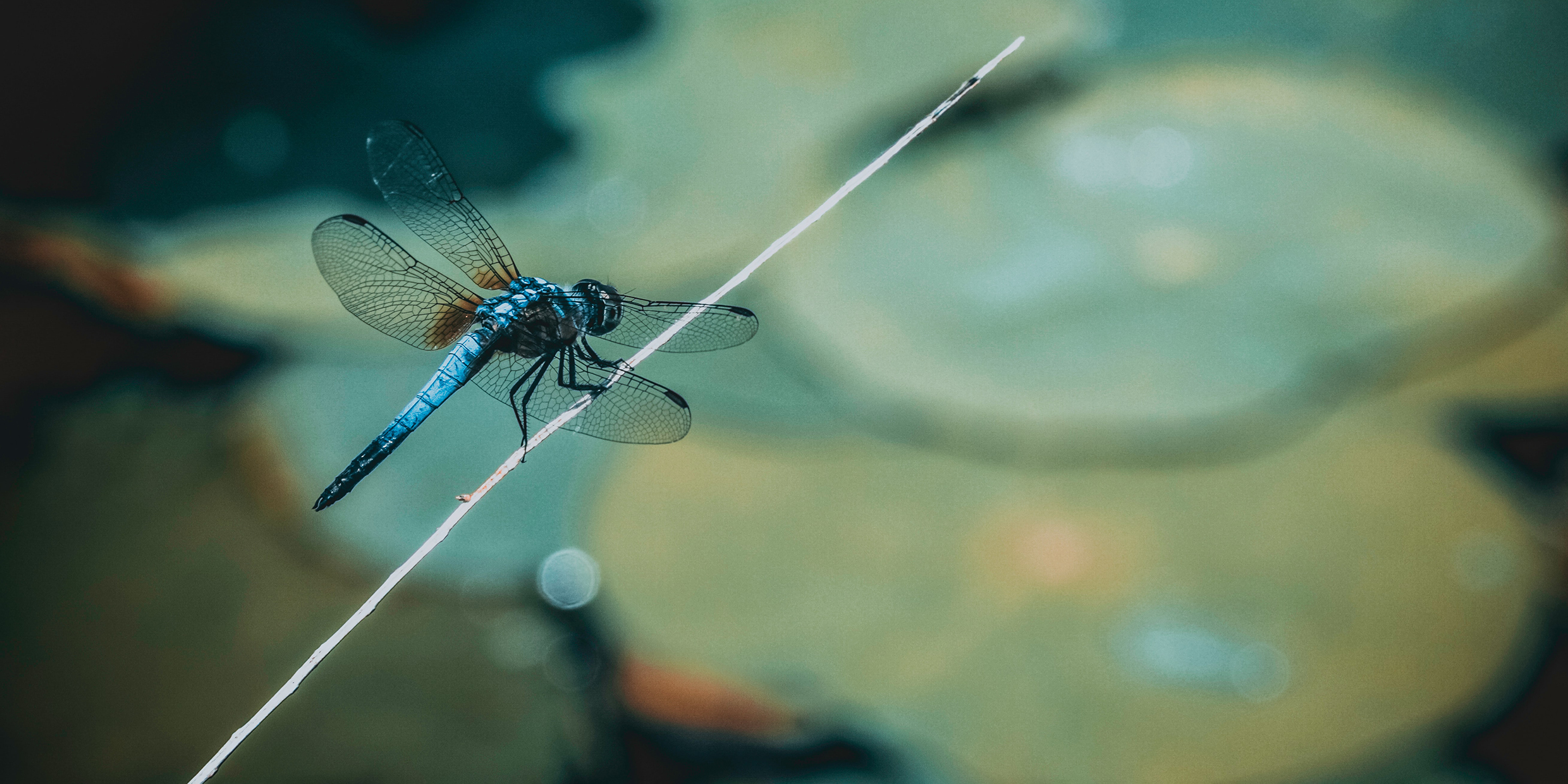Originally published 26 July 1993
Anyone who has watched a dragonfly scout a summer pond has seen one of the wonders of evolution.
A cross between a traffic-watch chopper and an F‑16. A flawless match of form and function. A flying machine optimized for snapping up insects on the wing.
And for sex. But more of that in a minute.
Every now and then evolution throws up a creature so perfectly adapted to its way of life that improvement seems impossible. Such species are rewarded by longevity. They survive for eons with little change. They become what evolutionary biologists call “living fossils.”
The dragonfly is a living fossil, one of the oldest orders in the animal kingdom.
One famous dragonfly fossil from the Jurassic limestone of Germany is 200 million years old. Every wing vein is recorded with astonishing fidelity. The pattern matches in almost every detail the drawing of a dragonfly wing in my Peterson Field Guide to the Insects. The fossil insect seems ready to take flight, released from a 200-million-year sleep to join its modern cousins.
Dragonfly fossils have been found in rocks as old as the Carboniferous Era of Earth history, 300 million years ago. Some of these ancient flyers had wingspans greater than two feet. Dinosaurs came and went, pterodactyls flourished and disappeared, thousands of species of mammals evolved and became extinct: Dragonflies go on and on, the Energizer bunnies of evolution.
Sit by the summer pond and watch them. You might as well be in a time warp. Glance up and see Triceratops grazing nearby. Or thundering Tyrannosaurus rex. Asteroids smash into the earth and reptilian giants become extinct; the dragonfly survives.
Entomologists separate the order Odonata into dragonflies and the more delicate damselflies, but for most summer pond watchers, and in popular parlance, they are all the same.
Iridescent eyes, tens of thousands of glittering facets. Shimming blues and greens. Opal. Blood red. Ultramarine. No wonder dragonflies are talismans of summer, one of the few insects we welcome to the season of exposed skin.
Greybacks, clubtails, darners, biddies, and skimmers. Their names evoke poetry. Popular names are even more evocative. Water maidens. Demoiselles. Horse stingers. Mosquito hawks. Devil’s darning needles. Snake doctors.
When I was a kid, I was told dragonflies stitch up the eyes of sleeping children. They are also supposed to minister to injured snakes, sewing up wounds and nursing them back to health.
But it is the flying that makes it possible to sit for hours beside the pond or stream, watching them move. Dragonflies may be the most elegant flyers on the planet. Forwards, backwards, straight up or down. Zip. Spin. Stop on a dime. The center of gravity lies just below the base of the wings, with helicopter balance. Opposite wings are connected by strong flight muscles, and the two pairs of wings operate independently. A big dragonfly can reach an air speed of 60 miles per hour.
Pure flying machine. The dragonfly’s legs are not made for walking, but for clutching a reed or twig when it comes to rest. Or for scooping up flying insects. The dragonfly uses its netted legs like a shopping cart. It has been known to gather up 100 mosquitoes at a time.
I have a special place for watching aquatic insects, a plank bridge across a sluggish stream on conservation land. Lay prone and your face is a foot from the surface of the water. Water striders and whirligigs in the late spring. Backswimmers in the fall. And dragonflies in summer.
The males take up territories near the banks of the stream. Perching on reeds or stones. Chasing off intruding males. Patrolling. It’s a dominance sort of thing. Establishing priority. The male in charge get the chance to mate.
But there’s a bit a business to take care of first. The male’s genital opening is near the tip of his tail. The penis, however, is just behind the legs. So before he mates, the male must transfer sperm from the tip of the tail to the penis up front.
Now he grasps the female behind her head with the tip of his tail. She curls her abdomen around and under until she brings her genital organ — at the tip of her tail — to his penis. Now their bodies are engaged in a heart-shaped valentine, one of nature’s more engagingly semiotic acts of copulation. Sometimes they stay in this position for a perplexingly long time, perhaps to ensure fertilization, or maybe because they are too love-besotted to let go.
Many dragonfly pairs do not disengage even when they disentangle their valentines. They dart about in tandem, the male still grasping the female’s neck while she lays the eggs. Every pond-watcher has seen these linked pairs, as adept at doubled post-coital flight as when solitary.
Evolutionists tell us that silverfish are the most ancient insects that survive more or less unchanged into the present. Cockroaches and dragonflies are almost as old. Of these living fossils only the dragonfly is an unmitigated boon to humans. An iridescent exterminator. A 300-million-year-old beauty on the wing.



